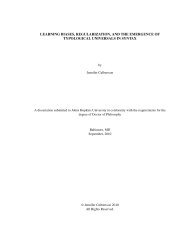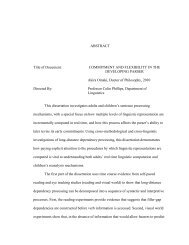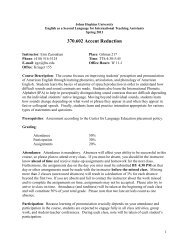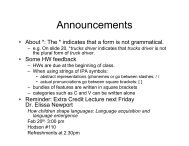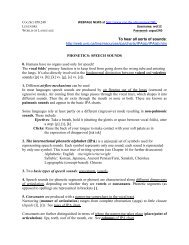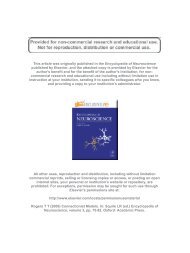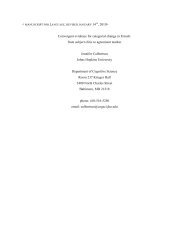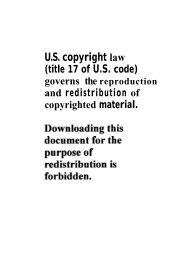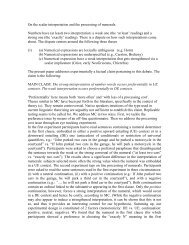Children's Comprehension and Production of Compound Nouns in ...
Children's Comprehension and Production of Compound Nouns in ...
Children's Comprehension and Production of Compound Nouns in ...
Create successful ePaper yourself
Turn your PDF publications into a flip-book with our unique Google optimized e-Paper software.
<strong>of</strong> compound nouns. 30 Korean-speak<strong>in</strong>g children aged 3 to 4 participated <strong>in</strong> this study. As <strong>in</strong> the<br />
experiment by Nicoladis (2003), each child was asked to do two tasks: (1) compound production<br />
<strong>and</strong> (2) compound comprehension. First, the compound production task <strong>in</strong>cluded semi-<strong>in</strong>herently<br />
related objects, that is, <strong>in</strong>teract<strong>in</strong>g objects, such as flowers decorat<strong>in</strong>g chairs. The children were<br />
asked to look at one picture <strong>of</strong> multiple th<strong>in</strong>gs, then another picture <strong>of</strong> multiple th<strong>in</strong>gs <strong>and</strong> f<strong>in</strong>ally<br />
to name the third picture (a comb<strong>in</strong>ation <strong>of</strong> the previous two pictures). Next, on the compound<br />
comprehension task, the children were shown an array <strong>of</strong> four different pictures, separated by<br />
l<strong>in</strong>es. All pictures <strong>in</strong>cluded <strong>in</strong> the comprehension were different from those <strong>in</strong> the production<br />
task. The pictures describe each th<strong>in</strong>g alone, the th<strong>in</strong>gs comb<strong>in</strong>ed <strong>in</strong> some way <strong>and</strong> the th<strong>in</strong>gs<br />
next to each other. The children were asked to po<strong>in</strong>t to the named object <strong>in</strong> the array. Both the<br />
production <strong>and</strong> comprehension task were conducted on a portable computer. In addition, the 10<br />
test items <strong>and</strong> two filters for each task were also given to the participants.<br />
Results from the study showed that the 3-year-old <strong>and</strong> the 4-year-old children equally<br />
understood the mean<strong>in</strong>g <strong>of</strong> compound nouns (83.3% vs. 94.7%). In contrast with the<br />
comprehension task, 3-year-old children produced less compound nouns to name two <strong>in</strong>teract<strong>in</strong>g<br />
objects than 4-year-old children (42.7% vs. 83.3%). Therefore, these results demonstrate that<br />
Korean-speak<strong>in</strong>g children's knowledge <strong>of</strong> produc<strong>in</strong>g compound nouns cont<strong>in</strong>ues to develop<br />
throughout the preschool years, even though their knowledge <strong>of</strong> the mean<strong>in</strong>g <strong>of</strong> compound nouns<br />
appeared very early. In contrast with the previous study by Nicoladis (2003), the present study<br />
further shows that children's comprehension exceeds their production level. F<strong>in</strong>ally, it shows that<br />
the 3-year-old children preferred to choose the head noun rather than choose the modify<strong>in</strong>g noun<br />
when they made a s<strong>in</strong>gle-word response, suggest<strong>in</strong>g that they know the subcategorization<br />
function <strong>of</strong> compound nouns.<br />
References<br />
Berman, Richard. 1987. A developmental rout: Learn<strong>in</strong>g about the form <strong>and</strong> use <strong>of</strong> complex<br />
nom<strong>in</strong>als <strong>in</strong> Hebrew. L<strong>in</strong>guistics 25, 1057-1085.<br />
Berman, Richard., <strong>and</strong> Clark, Eve. 1989. Learn<strong>in</strong>g to use compounds for contrast: Data from<br />
Hebrew. First Language 9, 247-270.<br />
Clark, Eve. 1993. The lexicon <strong>in</strong> acquisition. Cambridge: Cambridge University Press.<br />
Clark, Eve., <strong>and</strong> Berman, Richard. 1988. Types <strong>of</strong> l<strong>in</strong>guistic knowledge: Interpret<strong>in</strong>g <strong>and</strong><br />
produc<strong>in</strong>g compound nouns. Journal <strong>of</strong> Child Language 14, 547-567.<br />
Clark, Eve., <strong>and</strong> Berman, Richard. 1984. Structure <strong>and</strong> use <strong>in</strong> the acquisition <strong>of</strong> word formation.<br />
Language 60, 542-590.<br />
Fabb, Nigel. 1998. <strong>Compound</strong><strong>in</strong>g. The h<strong>and</strong>book <strong>of</strong> morphology, eds. by Spencer Andrew &<br />
Gottfried, Gail. 1997. Comprehend<strong>in</strong>g compounds: Evidence for metaphoric skill? Journal <strong>of</strong><br />
Child Language 24, 163-186.<br />
Mellunius, Iris. 1996. <strong>Children's</strong> comprehension <strong>of</strong> Swedish nom<strong>in</strong>al compounds. <strong>Children's</strong><br />
language, eds. by Johnson Carolyn & Gilbert John, 167-182. Mahwah, NJ: Erlbaum.<br />
Nicoladis, Elena. 2003. What compound nouns mean to preschool children. Bra<strong>in</strong> <strong>and</strong> Language<br />
84, 38-49.



